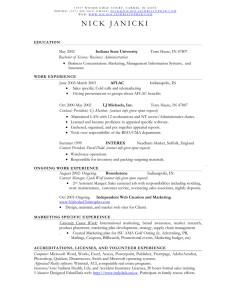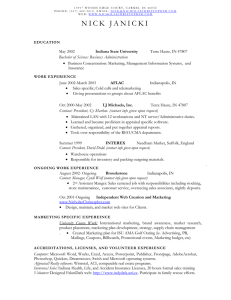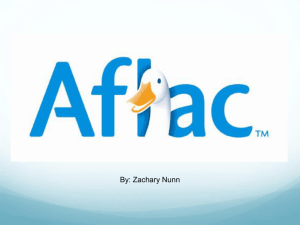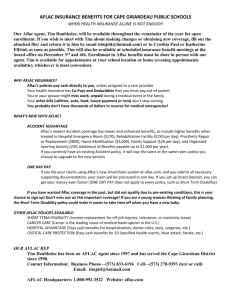CL139.doc
advertisement
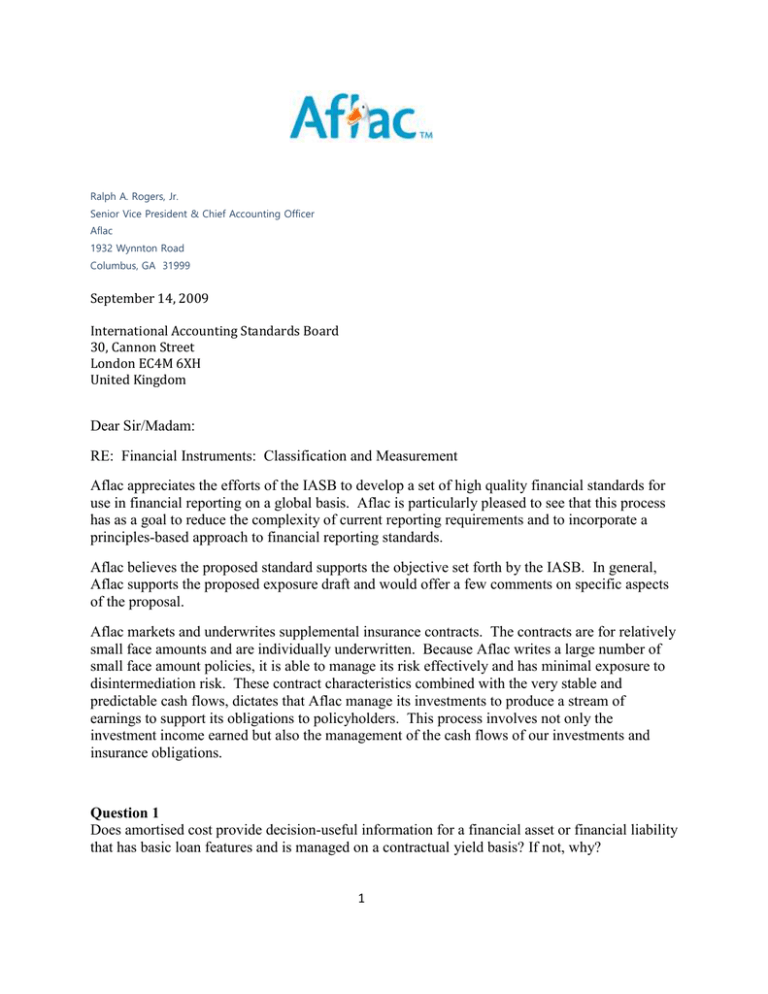
Ralph A. Rogers, Jr. Senior Vice President & Chief Accounting Officer Aflac 1932 Wynnton Road Columbus, GA 31999 September 14, 2009 International Accounting Standards Board 30, Cannon Street London EC4M 6XH United Kingdom Dear Sir/Madam: RE: Financial Instruments: Classification and Measurement Aflac appreciates the efforts of the IASB to develop a set of high quality financial standards for use in financial reporting on a global basis. Aflac is particularly pleased to see that this process has as a goal to reduce the complexity of current reporting requirements and to incorporate a principles-based approach to financial reporting standards. Aflac believes the proposed standard supports the objective set forth by the IASB. In general, Aflac supports the proposed exposure draft and would offer a few comments on specific aspects of the proposal. Aflac markets and underwrites supplemental insurance contracts. The contracts are for relatively small face amounts and are individually underwritten. Because Aflac writes a large number of small face amount policies, it is able to manage its risk effectively and has minimal exposure to disintermediation risk. These contract characteristics combined with the very stable and predictable cash flows, dictates that Aflac manage its investments to produce a stream of earnings to support its obligations to policyholders. This process involves not only the investment income earned but also the management of the cash flows of our investments and insurance obligations. Question 1 Does amortised cost provide decision-useful information for a financial asset or financial liability that has basic loan features and is managed on a contractual yield basis? If not, why? 1 Response 1 We believe that, for companies such as Aflac, amortized cost does provide decision-useful information to the user of its financial statements. Aflac manages its investment portfolio on a contractual yield basis and its portfolio consists primarily of instruments that have basic loan features. This proposal will produce financial statements that are representative of operations of Aflac and represent the manner in which it manages its business. Financial statements that reflect the manner in which the company is managed are more useful to investors and others in understanding the success of management’s decisions and activities to produce value for stockholders and to fulfill its obligations to other stakeholders. Question 2 Do you believe that the exposure draft proposes sufficient, operational guidance on the application of whether an instrument has ‘basic loan features’ and ‘is managed on a contractual yield basis’? If not, why? What additional guidance would you propose and why? Response 2 We support the Board’s guidance on this point. Question 3 Do you believe that other conditions would be more appropriate to identify which financial assets or financial liabilities should be measured at amortised cost? If so, (a) what alternative conditions would you propose? Why are those conditions more appropriate? (b) if additional financial assets or financial liabilities would be measured at amortised cost using those conditions, what are those additional financial assets or financial liabilities? Why does measurement at amortised cost result in information that is more decisionuseful than measurement at fair value? (c) if financial assets or financial liabilities that the exposure draft would measure at amortised cost do not meet your proposed conditions, do you think that those financial assets or financial liabilities should be measured at fair value? If not, what measurement attribute is appropriate and why? Response 3 As an alternative, Aflac supports the classification of certain hybrid securities at amortized cost. Aflac has invested in Tier 1, Upper Tier 2 and Lower Tier 2 securities of major financial institutions around the world. These securities were purchased and are managed for the investment return from the interest income and for the cash flows from the expected interest income and principal payments. Some of these securities have a stated or fixed maturity date and would qualify for the amortized cost model. Others have an expected maturity date which is driven by economic factors. To date, each of these securities owned by Aflac which have an economic maturity date have been repaid on the expected repayment date even though it may have been economically advantageous to the issuer to extend the maturity of the security. These securities have traded and performed as a fixed maturity security. Therefore, Aflac believes a 2 provision should be provided to allow these securities to be reported and accounted for on an amortized cost basis as are other securities which have basic loan features and are managed on a contractual yield basis. If the Board does not believe this should be permitted on a prospective basis, Aflac would encourage the Board to allow a “grandfathering” of this type of security owned as of July 1, 2009, and require disclosure of this election and the relevant information regarding this election. For Aflac these securities were acquired with a certain expectation as to their performance and financial reporting and accounting. To date the securities owned by Aflac have performed as expected; however, based upon this proposal, there will be a deviation in the expected financial reporting and accounting resulting from a change in the related financial reporting principles which is not in keeping with actual results to date. Aflac is proud of its transparency in its financial reporting. At present, Aflac posts a list of these securities each quarter on its web site along with the market values, amortized cost, par value, and credit ratings for each of these securities. There is sufficient information available for the investor or other interested party to be fully informed regarding the securities owned by Aflac. Question 4 (a) Do you agree that the embedded derivative requirements for a hybrid contract with a financial host should be eliminated? If not, please describe any alternative proposal and explain how it simplifies the accounting requirements and how it would improve the decision-usefulness of information about hybrid contracts. (b) Do you agree with the proposed application of the proposed classification approach to contractually subordinated interests (ie tranches)? If not, what approach would you propose for such contractually subordinated interests? How is that approach consistent with the proposed classification approach? How would that approach simplify the accounting requirements and improve the decision usefulness of information about contractually subordinated interests? Response 4 Aflac supports the Board’s position on embedded derivatives. We ask that the Board reconsider its conclusions related to subordinated interests. We believe that a subordinated tranched security should not automatically be excluded from the amortized cost classification. If an investment’s cash flows are considered reliable by the company to the point of using the investment to back product liabilities, then that should be an indicator that it is managed on a contractual yield and should qualify for amortized cost treatment. If a distinction should be made related to subordinated interest, it should be based on whether the security is above or below investment grade. Question 5 Do you agree that entities should continue to be permitted to designate any financial asset or financial liability at fair value through profit or loss if such designation eliminates or significantly reduces an accounting mismatch? If not, why? Response 5 Aflac agrees that entities should continue to be permitted to designate any financial asset or financial liability at fair value through profit or loss if such designation eliminates or significantly reduces an accounting mismatch. 3 Question 6 Should the fair value option be allowed under any other circumstances? If so, under what other circumstances should it be allowed and why? Response 6 Aflac does not believe that the fair value option should be extended under any other circumstances. Aflac is not aware of a need for additional exceptions. Question 7 Do you agree that reclassification should be prohibited? If not, in what circumstances do you believe reclassification is appropriate and why do such reclassifications provide understandable and useful information to users of financial statements? How would you account for such reclassifications, and why? Response 7 Aflac generally agrees with the concept except where the accounting standards have been changed such that the reporting entity would in its judgment have made a different determination had it known that the new accounting and reporting principles would be adopted. To the extent that management believes the reclassification provides a view of the operations and financial position which is consistent with the management of the operations and assets and liabilities, it should be allowed upon the adoption of the new accounting standard that is promulgated to make a reclassification as appropriate. Adequate disclosure of the change and the reason it is more appropriate than continuing the former classification should be required. In addition, Aflac believes that the Board should permit reclassifications in very limited circumstances such as the downgrade of a security to below investment grade. Full disclosure of these reclassifications should be provided. Aflac currently follows this policy for certain of its securities. Question 8 Do you believe that more decision-useful information about investments in equity instruments (and derivatives on those equity instruments) results if all such investments are measured at fair value? If not, why? Response 8 Aflac believes fair value is the appropriate basis for reporting equity investments because the primary purpose for investing in these vehicles is the generation of appreciation in value and not current income. Typically, equity instruments are not held for the generation of investment income since the periodic return, such as a dividend, is not nearly as attractive as the return on an instrument that has the features of a basic loan instrument. In order to compensate for the lack of periodic return, the investor is expecting the value of the equity instrument to increase as a result of the performance of the entity which issued the instrument. This growth in value should be reflected in operating earnings. 4 Question 9 Are there circumstances in which the benefits of improved decision-usefulness do not outweigh the costs of providing this information? What are those circumstances and why? In such circumstances, what impairment test would you require and why? Response 9 Aflac is not aware of a circumstance in which the benefits of providing of this information would not out weigh the costs of providing this information. Question 10 Do you believe that presenting fair value changes (and dividends) for particular investments in equity instruments in other comprehensive income would improve financial reporting? If not, why? Response 10 Aflac believes that any equity investment is held for the production of economic gain for its stockholders. In order to reflect that economic gain in its operations, the income received from and the increases and decreases in the fair value of that investment must be included in the operating earnings of the period in which they occurred. To include them in equity indicates the gains or losses are the result of stockholder transactions. Aflac does not believe this provides a faithful representation of the results for the period under measurement. Question 11 Do you agree that an entity should be permitted to present in other comprehensive income changes in the fair value (and dividends) of any investment in equity instruments (other than those that are held for trading), only if it elects to do so at initial recognition? If not, (a) how do you propose to identify those investments for which presentation in other comprehensive income is appropriate? Why? (b) should entities present changes in fair value in other comprehensive income only in the periods in which the investments in equity instruments meet the proposed identification principle in (a)? Why? Response 11 Aflac’s response to question 10 is also applicable to this question. Question 12 Do you agree with the additional disclosure requirements proposed for entities that apply the proposed IFRS before its mandated effective date? If not, what would you propose instead and why? Response 12 Aflac agrees with the disclosure requirements proposed. 5 Question 13 Do you agree with applying the proposals retrospectively and the related proposed transition guidance? If not, why? What transition guidance would you propose instead and why? Response 13 Aflac believes the retrospective application of the proposed standard is appropriate and can be accomplished in a reasonable fashion. Question 14 Do you believe that this alternative approach provides more decision-useful information than measuring those financial assets at amortised cost, specifically: (a) in the statement of financial position? (b) in the statement of comprehensive income? If so, why? Response 14 Aflac does not believe that this alternative approach would provide useful information to financial statement users. Having an alternative approach would only add confusion to the financial reporting between companies. It would not add value or credibility to the financial statements. It would not add to the understanding of how management manages the company’s operations and creates value. Question 15 Do you believe that either of the possible variants of the alternative approach provides more decision-useful information than the alternative approach and the approach proposed in the exposure draft? If so, which variant and why? Response 15 Aflac supports the approach proposed in the exposure draft. From Aflac’s perspective the other variants do not provide information about the company’s operations that is as useful as the proposed approach. Aflac appreciates the opportunity to comment on the exposure draft and is generally supportive of the IASB’s proposed financial reporting standard. Sincerely, Ralph A. Rogers, Jr. 6
